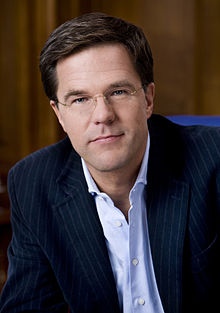Prime Minister of the Netherlands
| Prime Minister of the Netherlands Minister-president |
|
|---|---|

State Coat of Arms of the Kingdom of the Netherlands
|
|
| Ministry of General Affairs | |
| Style | His Excellency |
| Member of |
Council of Ministers European Council |
| Residence | Catshuis, The Hague, Netherlands |
| Appointer |
Willem-Alexander as King of the Netherlands |
| Term length | 4 years No term limit |
| Formation | March 25, 1848 as Chairman of the Council of Ministers 24 June 1945 as Minister-President |
| First holder |
Gerrit Schimmelpenninck as Chairman of the Council of Ministers Wim Schermerhorn as Minister-President |
| Deputy | Deputy Prime Minister |
| Salary | €144,000 (incl. €7,887.24 expenses) |
| Website | Ministry of General Affairs |
The Minister-President of the Netherlands (Dutch: Minister-president van Nederland), commonly referred to in English as the Prime Minister, is the head of the executive arm of the Dutch government and the chairman of the Council of Ministers of the Netherlands. He is the de facto head of government of the Netherlands and coordinates the policy of the government. The current prime minister is Mark Rutte.
Although he is the most important political figure in the Netherlands, the Prime Minister is not as powerful as his British and German counterparts. This is mainly because, due to the Dutch system of proportional representation, it is nearly impossible for one party to get a majority of seats in the House of Representatives (lower house). Therefore, the government is always a coalition between two or more parties. Because of his limited powers, the prime minister is described as primus inter pares (first among equals).
As a result of the constitutional review of 1983, the position of Prime Minister was inscribed into the Dutch constitution for the first time. According to the constitution, the Government is constituted by the King and the ministers. The constitution stipulates the Prime Minister chairs the council of ministers (article 45) and is appointed by royal decree (article 43). The royal decree of their own appointment and those of the other ministers are to be countersigned by the Prime Minister (article 48).
The Prime Minister chairs the weekly meetings of the council of ministers and has the power to set the agenda of these meetings. The prime minister is also Minister of General Affairs (Minister van Algemene Zaken), which takes an important role in coordinating policy and is responsible for the Government Information Service (Dutch: Rijksvoorlichtingsdienst). The Prime Minister is also responsible for the royal house and has a weekly meeting with the King on government policy. Informally the Prime Minister functions as the "face" of the cabinet to the public. After the meetings of the cabinet on Friday, the Prime Minister hosts a press conference on the decisions of the cabinet and current affairs. The Prime Minister also has some functions in international affairs, attending the European Council every six months and maintaining bilateral contacts. The Prime Minister's office is a hexagon shaped tower, named "The Little Tower" Het Torentje on the Binnenhof in The Hague. The official residence (which is only used for official functions) is the Catshuis.
...
Wikipedia

